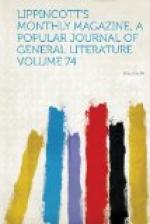The final reconstruction of the city was not begun in earnest until 1857, and occupied ten years or more. The walls were leveled to the ground, the moat was filled in, a broad girdle-street (the Ringstrasse) laid out to encircle the inner city, and the adjacent ground on either side was converted into building-lots. In this brief space of time Vienna was changed from a quasi-mediaeval town to a modern capital of the most pronounced type. The Ringstrasse became a promenade like that of the old Paris boulevards, but broader, grander and lined with palatial edifices no whit inferior to the French. The metamorphosis is so startling that a tourist revisiting the city after an absence of twenty years would have difficulty in persuading himself that he was indeed in the residence of Maria Theresa, Joseph II. and Metternich. No American city can exhibit a like change in the same time. Our cities, although expanding incessantly, have preserved their original features. Even new Chicago, springing from the ashes of the old, has not departed from the former ground-plan and style of building. And no American city can point to a succession of buildings like the Franz Joseph Barracks, the Cur Salon with its charming park, the Grand Hotel and the Hotel Imperial, the Opera-house, the Votive Church, the new Stock Exchange, and the Rudolf Barracks. When the projected House of Deputies, the City Hall, and the University building are completed, the Ring street will deserve to stand by the side of the Rue de Rivoli and the Champs Elysees. The quondam suburbs (Vorstaedte), eight in number, are now one with the city proper. Encircling them is the mur d’ octroi, or barrier where municipal tolls are levied upon articles of food and drink. Outside of this barrier, again, are the suburbs of the future, the Vororte, such as Favoriten, Fuenfhaus, Hernals, etc. The growth of the population is rapid and steady. In 1714 it was 130,000, in 1772 only 193,000. A century later, in 1869, it had risen to 811,000 (including the Vororte); at the present day it can scarcely fall short of 1,000,000.




